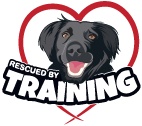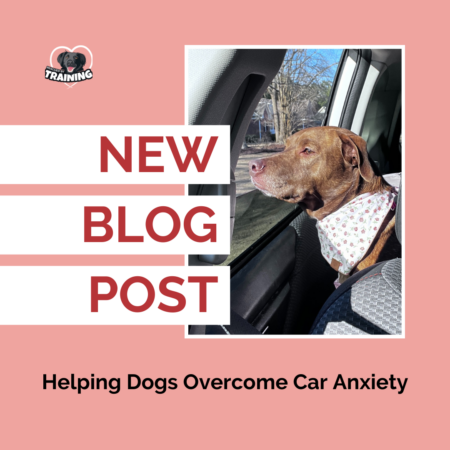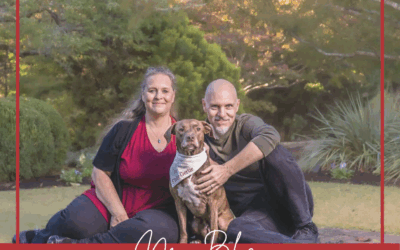There are few joys better than watching a dog enjoy a car ride, with their head poking out of the window (while they’re safely tethered), watching the world go by. But for some dogs, they seem to hate car rides, showing signs of clear anxiety like panting, shaking, pacing, drooling or hesitance to even go in the car. This is something I recently experienced with our newly adopted dog, Gertie. The first several weeks we had her, she was panting, unsettled and visibly shaking in the car.
Car anxiety in dogs can stem from several factors, but it’s often a bit of chicken or egg situation, to figure out which is causing the root problem. Is the dog anxious about being in the car and this makes him feel sick? Or is the dog suffering from motion sickness and has become anxious in the car as a result?
If a dog is experiencing motion sickness it can lead to nausea or just feeling icky and because of how dogs learn, the dog learns to associate that cars predict feeling yucky. If this happens it creates a negative association with the car, which can turn into fear or avoidance of the car. Similarly, lack of socialization to the car where the dog has not been properly introduced to car travel may find the experience uncertain or scary, compounded by the unpredictable movements and general bounciness of car rides. Or, if the dog has experienced too many negative trips in car, like only going in the car to go to the vet, they may begin to associate car rides with scary things. Or, if the dog is anxious about the car to begin with, that can cause the dog to feel physically sick. And then the dog doesn’t like the car, all thanks to association learning!
Puppies commonly have car sickness, partly because their inner ear, which is responsible for balance, isn’t fully developed until around 1 year old so puppies and younger dogs may eventually outgrow motion sickness, but we still want to prevent them from developing negative associations, so it’s still worth discussing with your vet so you don’t have to undue that emotional damage later!
I’ve written in the past about the link between physical pain and behavior where I suspected the dog was in pain based on my behavior consult and recommended the client have a vet check, which confirmed the dog indeed did have pain or something physical going on. And car anxiety can be similar if there is motion sickness or underlying anxiety/fear, because this needs vet intervention.
For many dogs, professional training will be necessary because the vicious cycle of nausea causes vomiting which causes anxiety or anxiety causes nausea which causes vomiting has been going on for so long that even if the anxiety or nausea is address, the negative associations have been solidly affirmed and that needs professional training help.
Identifying Motion Sickness or Anxiety
We know dogs can be stoic when they’re uncomfortable so learning dog body language and being aware of signs of anxiety in the car is critical.
Common signs include:
- Panting
- Drooling
- Whining, barking or other vocalizations
- Trembling or shaking
- Pacing or inability to settle
- Attempting to escape
- Vomiting
- Diarrhea
- Refusing to get in or approach the car
In Gertie, I suspected pain was contributing to her anxiety, since we discovered she had several ortho issues. There was also a possibility that she had some negative associations because she was picked up as a stray and we could surmise that it’s possible her only previous car experiences were when she was picked up by animal control and brought to the shelter…definitely not a positive first experience. And, it’s also likely her hip and pelvic fracture were caused by being hit by a car. I didn’t think she was motion sick, as she wasn’t drooling and she was happily taking food, even though she was panting and pacing and shaking.
Helping Gertie Overcome Car Anxiety
Since I suspected pain with Gertie as a first line cause of her anxiety, we worked with our vet to get pain medication and I came up with an incremental training plan and data tracking to monitor her progress. First, I decided to crate her for car rides. Crating restricted her movement, allowing her to be more stable during car rides, reducing the chance that the movement and bouncing of the car was contributing to her being painful. Uncrated she had to try to stabilize herself and this likely was painful.
We did this for several days, taking very slow, short trips around the neighborhood (1-5 minutes at 10-15 mph to start) and fed her during these short outings. She was not showing any signs of distress or discomfort during these trips so we gradually increased the distance and speed of the car and she continued to be comfortable over the next two weeks. With pain meds on board and several weeks of of positive experiences of taking her to fun places like the park and for ice cream, we decided to remove the crate from the equation. We removed the crate but added a donut bed in the backseat for a few days, thinking she could curl up in it if she was feeling unstable. She didn’t use it much and would just stand in it looking out the window, so we removed it after a few trials.
And then she was comfortable and started enjoying car rides!
She was happily watching the world go by with her head out the window and she was rolling in the backseat. She loves to roll, so we knew this was a definite sign of comfort for her. She was taking high value food or would work on a long lasting chew.
We don’t know exactly what the “fix” was because we started both positive conditioning (going to fun places, using high value food) and pain medication at the same time. But it’s like a combination – we reduced her pain and were making the car be fun. And we’re so happy she’s comfortable now as we have a long road trip in our future!
If your dog is showing clearer signs of motion sickness like drooling, lip licking or smacking, refusal to take high value food or vomiting, you need to consult your vet to discuss this. If your dog has known pain issues like arthritis or other joint issues, that needs to be discussed with your vet, as pain from that could be a contributing factor if your dog is uncomfortable in the car. And If we suspect your dog is primarily anxious which is causing the dog to be physically uncomfortable, then discussing situational anti-anxiety medication with your vet may be appropriate.
The takeaway: car anxiety in dogs can be frustrating, but with some detective work to sort out the underlying cause, training and sometimes appropriate medication, we can help your dog feel more comfortable and learn the car is a safe place to be and car rides can become enjoyable experiences filled with exciting new adventures!
Be sure to sign up for my free weekly newsletter so you don’t miss out on big announcements, videos, personal stories, client successes and more!
Contact me and schedule a session if you need help.
If you would like to support my efforts and make a contribution to allow me to continue to create free resources like blog and all of my other free resources, you can Buy Me A Coffee!

Happy training!
![]()




